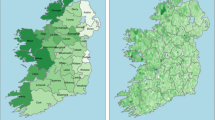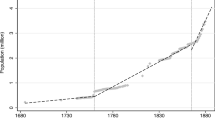Abstract
This paper uses the exogenous variation in fertility introduced by China’s family planning policies to identify the impact of child quantity on child quality. We find that the number of children has a significant negative effect on child height, which supports the quality–quantity trade-off theory. Our instrumental quantile regression approach shows that the impact varies considerably across the height distribution, particularly for boys. However, the trade-off is much weaker if quality is measured by educational attainments, suggesting that the measurement of child quality is also crucial in testing the quality–quantity trade-off theory.








Similar content being viewed by others
Notes
The claim is supported by our sensitivity analysis conducted in Section 5.
Wu and Li (2012) indeed find that mothers with fewer children have higher calorie intake.
For example, Short and Zhai (1998) show that the median amount of cash subsidies accounts for less than 2 % of household income.
Out of the 932 ever-married women in our sample, 46 of them lost at least one child before 1993. Seventy-seven percent of the deceased children died before age 2. To examine whether families with deceased children are comparable to other families, we regress our quantity and quality measures on a dummy variable ( = 1 for families who lost at least one child and 0 otherwise) and a series of family and community characteristics. When the number of children is used as the dependent variable, the coefficient on the deceased-child dummy is − 0. 107 ( SE = 0. 137) for the boy sample and − 0. 002 ( SE = 0. 181) for the girl sample. When child height is used as the dependent variable, the coefficient on the deceased-child dummy is − 0. 168 ( SE = 0. 142) for the boy sample and − 0. 079 ( SE = 0. 159) for the girl sample. Consequently, we do not distinguish these families from others.
All these multiple births are twins. Children from families with twins are shorter than others. While it is possible to use twin births as an instrument for family size, the small number of twins makes it impractical for us. Given the small number of families with twins, excluding children from these families is unlikely to have any significant effect on our results.
The dependent variable is the log of annual household income and the independent variable includes paternal height, maternal height, maternal age and its squared, paternal age and its squared, and the province of residence dummies. The coefficient on paternal height is 0.010 ( SE = 0. 004) and on maternal height is 0.011 ( SE = 0. 005).
According to the Chinese Compulsory Education Law, the official school entry age is 6, but in some areas where the school system cannot cope with the demand, the school entry age can be set at 7. Using the CHNS data, we find that the school enrollment rate is only about 40 % for 6-year-olds but increases to 76 % for 7-year-olds, suggesting that the norm is 7. Therefore, we focus our analysis on 7–16-year-olds.
We have to exclude children whose mother did not participate in the 1993 SEMW as we do not know how many siblings they had.
Admittedly, none of these variables are perfect measures of family wealth. However, as pointed out by Angrist and Pischke JS (2008), including a proxy of wealth in the regression could still be an improvement over not controlling for wealth at all.
The reason for using the height of adult men is that most men live in the villages where they were born, but many women left their home village after marriage. Based on the information extracted from the 1993 SEMW, the median distance between a married woman’s house and her mother’s house was 5 km, and more that 75 % of married women lived at least 2 km from their mother’s house. The evidence suggests that more than half of married women do not live in their home village.
Adding additional control variables has no impact on our conclusion.
To check whether our results are mostly driven by these 30 large families, we run regressions excluding the 111 children from these families. The IV A estimate of the Q-Q trade-off effect is − 0. 527 ( SE = 0. 178) for boys and − 0. 614 ( SE = 0. 227), which are comparable to the estimates using the entire sample.
To check whether our results are sensitive to excluding these observations, we have also run regressions using the full sample with missing-father dummy as an additional control variable. When paternal height is used as the dependent variable, the coefficient on the number of children is 0.368 ( SE = 1. 022) for the boy sample and − 0. 005 ( SE = 1. 157) for the girl sample. When maternal height is used as the dependent variable, the coefficient on the number of children is 0.873 ( SE = 0. 822) for the boy sample and − 0. 554 ( SE = 1. 091) for the girl sample.
The covariance matrix of the estimates \(\hat \theta (\tau )\) is provided in the Appendix
The norm is defined as age − 6. The coefficient on the number of siblings is − 0. 119 ( SE = 0. 090) for the IV approach and − 0. 072 ( SE = 0. 031) for the OLS approach.
References
Angrist JD, Pischke JS (2008) Mostly harmless econometrics: an empiricist’s companion. Princeton University Press, London
Angrist J, Lavy V, Schlosser A (2010) Multiple experiments for the causal link between the quantity and quality of children. J Labor Econ 28(4):773–824
Becker GS, Lewis HG (1973) Part 2” was deleted in reference Becker and Lewis 1973 since issue number provided is 2. Please check if correct. On the interaction between the quantity and quality of children. J Polit Econ 81(2):S279–S288
Black SE, Devereux PG, Salvanes KG (2005) The more the merrier? The effect of family composition on children’s education. Q J Econ 120(2):669–700
Bound J, Jaeger D, Baker R (1995) Problems with instrumental variables estimation when the correlation between the instruments and the endogenous explanatory variable is weak. J Am Stat Assoc 90(430):443–450
Chernozhukov V, Hansen C (2005) An IV model of quantile treatment effects. Econometrica 73(1):245–261
Chernozhukov V, Hansen C (2006) Instrumental quantile regression inference for structural and treatment effect models. J Econ 132(2):491–525
Chernozhukov V, Hansen C (2008) Instrumental variable quantile regression: a robust inference approach. J Econ 142(1):379–398
Conley D, Glauber R (2006) Parental educational investment and children’s academic risk: estimates of the impact of sibship size and birth order from exogenous variation in fertility. J Hum Resour 41(4)
Davin D (1985) The single-child family policy in the countryside. Chap. 2. In: Croll E, Davin D, Kane P (eds) China’s one-child family policy. Macmillan, London, pp 37–82
Ebenstein A (2011) Estimating a dynamic model of sex selection in China. Demography 48(2):783–811
Hanushek EA (1992) The trade-off between child quantity and quality. J Polit Econ 100(1):84–117
Imbens GW, Angrist JD (1994) Identification and estimation of local average treatment effects. Econometrica 62(2):467–475
Lee J (2008) Sibling size and investment in children’s education: an Asian instrument. J Popul Econ 21(4):855–875
Li H, Zhang J (2007) Do high birth rates hamper economic growth? Rev Econ Stat 89(1):110–117
Li H, Zhang J, Zhu Y (2008) The quantity-quality trade-off of children in a developing country: identification using Chinese twins. Demography 45(1):223–243
McElroy M, Yang DT (2000) Carrots and sticks: fertility effects of China’s population policies. Am Econ Rev 90(2):389–392
Mogstad M, Wiswall M (2010). Linearity in instrumental variables estimation: problems and solutions. IZA Discussion Papers 5216. Institute for the Study of Labor (IZA), Bonn
Mogstad M, Wiswall M (2011) Testing the quantity-quality model of fertility: estimation using unrestricted family size models. Technical report. New York University, New York
Parish W, Willis R (1993) Daughters, education, and family budgets: Taiwan experiences. J Hum Resour 28(4):863–898
Qian N (2009). Quantity-quality and the one child policy: the only-child disadvantage in school enrollment in rural China. Working Paper 14973. National Bureau of Economic Research, Cambridge
Rosenzweig MR, Wolpin KI (1980) Testing the quantity-quality fertility model: the use of twins as a natural experiment. Econometrica 48(1):227–240
Rosenzweig MR, Zhang J (2009) Do population control policies induce more human capital investment? Twins, birth weight, and China’s “one child” policy. Rev Econ Stud 76(3):1149–1174
Savage T, Derraik JG, Miles HL, Mouat F, Hofman PL, Cutfield WS (2013) Increasing maternal age is associated with taller stature and reduced abdominal fat in their children. PloS One 8(3):e58869
Scharping T (2003) Birth control in China, 1949-2000: population policy and demographic development. Routledge, New York
Shea J (2000) Does parents’ money matter? J Public Econ 77(2):155–184
Short SE, Zhai F (1998) Looking locally at China’s one-child policy. Stud Fam Plan 29(4):373–387
Thomas D (1994) Like father, like son; like mother, like daughter: parental resources and child height. J Hum Resour 29(4):950–988
Wang F, Yong C, Zheng Z, Gu B (2010) How well does fertility intention predict fertility behavior? A case study from China. Technical report. Department of Sociology, University of California, Irvine
Wu X, Li L (2012) Family size and maternal health: evidence from the one-child policy in China. J Popul Econ 25:1–24
Zhao M, Glewwe P (2010) What determines basic school attainment in developing countries? Evidence from rural China. Econ Educ Rev 29(3):451–460
Acknowledgments
We are grateful to three anonymous referees and the editor Junsen Zhang for valuable comments.
Author information
Authors and Affiliations
Corresponding author
Additional information
Responsible editor: Junsen Zhang
Appendix: The covariance matrix the IVQR estimator
Appendix: The covariance matrix the IVQR estimator
The covariance matrix of the estimates \(\hat {\theta } (\tau )=\left (\hat {\alpha }(\tau ),\hat {\beta }(\tau )\right )\) is provided by Chernozhukov and Hansen (2008):
where,
where K( · ) is the Gaussian kernel density function, h(τ) is the bandwidth of the kernel that is given by \(h(\tau )=1.06\times \min \left (\hat {\sigma }_{\hat {\epsilon }(\tau )},\; \frac {\mathrm {Interquartile\;range\;of}\hat {\epsilon }(\tau )}{1.349}\right)n^{-\frac {1}{5}}\), \(\left [\hat {\bar {J}}_{\beta },\hat {\bar {J}}_{\eta }\right ]^{\prime }\) is a partition of \( \hat{J}_{\theta}(\tau)^{-1} \) such that \( \hat{\bar{J}}_{\beta} \) is a dim(β) × dim(β, η) matrix, and \( \hat{\bar{J}}_{\eta} \) is a dim(η) × dim(β, η) matrix.
Rights and permissions
About this article
Cite this article
Liu, H. The quality–quantity trade-off: evidence from the relaxation of China’s one-child policy. J Popul Econ 27, 565–602 (2014). https://doi.org/10.1007/s00148-013-0478-4
Received:
Accepted:
Published:
Issue Date:
DOI: https://doi.org/10.1007/s00148-013-0478-4




